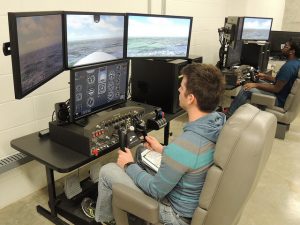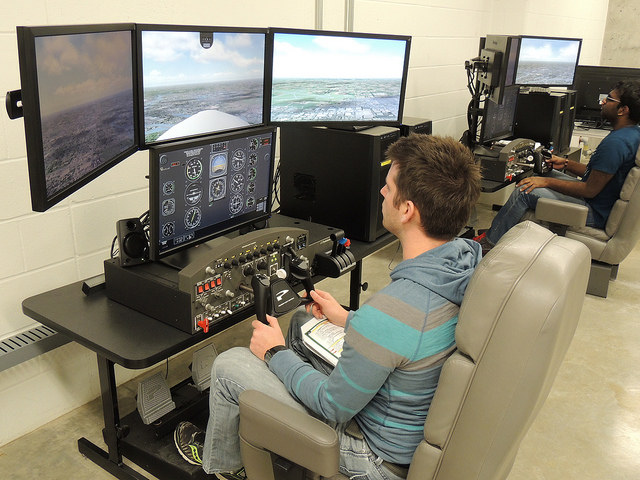Dr. Richard Wlezien, chair of the Department of Aerospace Engineering, wanted to make a required flight experience class something students would remember long after their time in the department. In order to do that, he hired someone who could bring that vision to life.
Wlezien, chair of the Department of Aerospace Engineering, wanted to make a required flight experience class something students would remember long after their time in the department. In order to do that, he hired someone who could bring that vision to life.
At the end of a long hallway in the basement of Howe Hall, there is a room that causes every passer-by to do a double take. The proud owner of this space is Col. Robert Martin (USAF ret.), a relatively new lecturer in the Department of Aerospace Engineering who teaches the flight experience course. In the time that he was been a member of the department, Col. Martin has taken an under-utilized space, made it useful again, and taken a required course to the next level through technology and team dynamics.
“The early challenge to changing this flight experience course was finding simulators we were happy with,” said Col. Martin. “I wanted devices that would provide students with a robust, challenging, and detailed flight experience. The goal was to make them want to be here. Working with Dr. Wlezien, we ended up getting the exact equipment necessary for the “wow” factor.”
This robust environment immerses students in the skill of flying but also in the complexities of aircraft. The simulator includes a 120 degree out-the-window field of view, a detailed instrument panel, and control panel in which every knob, switch and button are “hot” or live and respond to the pilot’s command. The simulator also includes a to-scale cockpit seat to allow the pilot to sit at the correct height and angle. All of this allows the students to get a realistic feel for what it would be like to taxi, take off, fly, and land a plane. The simulator runs an accurate aerodynamic model so what students see in flight is close to what they would feel in a real aircraft.
“When a pilot climbs into an airplane, flying is only part of the challenge. The pilot needs to start, observe and manage all of the systems on the aircraft. We provide the students with detailed checklists that are specific to the aircraft and simulation they are flying. They need to set all switches, start and check the engine for proper operating parameters as well as bringing electrical, fuel, pneumatic and navigation systems on line. I’ve tried to reinforce with them that this is a primary interface between engineers and pilots. How these systems and checklists operate are key.” Col. Martin said.
In addition to creating the immersive learning environment, Col. Martin took Dr. Wlezien’s ideas when building the desired learning objectives for the course. This starts with the flight experience but finishes with the concept of teamwork in an operational setting, something Col. Martin knows first hand. He modeled the final lesson on experiences he had during his 26 years in the US Air Force as a fighter pilot, instructor and commander. The students are placed into teams and given a task of executing a flight test mission to collect data on their aircraft. Each team is comprised of four members with defined titles and tasks to accomplish during the flight. However, the process of executing the mission is where the real learning happens.
“The flight simulator becomes the vehicle to challenge communication skills and team responsibilities in an operational setting. Roles are easy to define, but responsibilities are tough,” Col. Martin said. “This course is unlike anything else students have experienced. I’ve had them tell me they don’t want the class to end. They begin to learn to function as a team. Once they understand that concept, it will lead to success.”
AeroE 301 Flight Experience is taught each fall and spring semester and is required for juniors and seniors in aerospace engineering.
